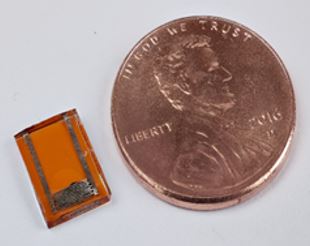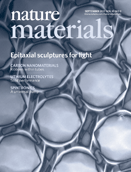Imani Jones & Daniel Cudzich Receive Honorable Mention NSF GRFP
Braun Lab Members Imani Jones (Ph.D. Candidate) and Daniel Cudzich (Undergraduate Researcher) were recently recognized with Honorable Mention for the National Science Foundation Graduate Research Fellowship Program. Congratulations on this national academic achievement!
________________________________________________________________________________________________________________
Professor Paul Braun recipient of the 2023-2024 College Award for Excellence in Translational Research
The Grainger College Award for Excellence in Translational Research honors faculty or staff researchers for special achievement in translational research. Examples of translational research include but are not limited to: entrepreneurial activities related to research outcomes, technology transfer of research through licensing of intellectual property, and research leading directly to products/outcomes with notable societal impact.
________________________________________________________________________________________________________________
Thermally engineering templates for highly ordered self-assembled materials
 Self-assembled solidifying eutectic materials directed by a template with miniature features demonstrate unique microstructures and patterns as a result of diffusion and thermal gradients caused by the template. Despite the template trying to force the material to solidify into a regular pattern, when the template carries a lot of heat it also can interfere with the solidification process and cause disorder in the long-range pattern. Researchers at the University of Illinois Urbana-Champaign and the University of Michigan Ann Arbor have developed a template material that carries almost no heat and therefore stops heat transfer between the template material itself and the solidifying eutectic material. This was accomplished by forming the template from a material with very low thermal conductivity, ultimately resulting in highly organized self-assembled microstructures.
Self-assembled solidifying eutectic materials directed by a template with miniature features demonstrate unique microstructures and patterns as a result of diffusion and thermal gradients caused by the template. Despite the template trying to force the material to solidify into a regular pattern, when the template carries a lot of heat it also can interfere with the solidification process and cause disorder in the long-range pattern. Researchers at the University of Illinois Urbana-Champaign and the University of Michigan Ann Arbor have developed a template material that carries almost no heat and therefore stops heat transfer between the template material itself and the solidifying eutectic material. This was accomplished by forming the template from a material with very low thermal conductivity, ultimately resulting in highly organized self-assembled microstructures.
“The key novelty of this research is that we carefully controlled the flow of heat. By controlling the flow of heat, the pattern becomes far better and more regular than before because we’re controlling more of the parameters. Previously, the template controlled the flow of atoms, but the heat flows were uncontrolled,” says Paul Braun, a professor of materials science and engineering and director of the Materials Research Laboratory, who led this research along with postdoctoral researcher Sung Bum Kang.
The results of this research were recently published in the journal Advanced Materials.
Read the full story by Amber Rose: https://mrl.illinois.edu/news/64349
Research Article: https://doi.org/10.1002/adma.202308720
________________________________________________________________________________________________________________
Editors Choice – 2023
Braun Lab publication, “Serially integrated high-voltage and high power miniature batteries,” included in the Editors Choice 2023 for Cell Reports Physical Science. See the full list of selected publications: Editors Choice — 2023
U.S. Department of Energy Awards $2 Million for Innovations to Source Domestic Lithium From Geothermal Brines
The U.S. Department of Energy (DOE) today announced the winners of its first-ever American-Made Geothermal Lithium Extraction Prize. Three teams will split a total of $2 million for prototyped innovations to directly extract lithium from the hot water used to produce geothermal energy, known as geothermal brines. Lithium is a crucial element in the clean energy supply chain, but the United States currently imports about 99% of its lithium supply. Work under the prize helps support access to cost-effective, domestic sources of this critical mineral for batteries for stationary storage and electric vehicles—crucial to meet the Biden-Harris Administration’s goals of 50% electric vehicle adoption by 2030 and a net-zero emissions economy by 2050. Advancing geothermal lithium extraction will also help ensure American leadership in the clean energy future and create U.S. jobs and a strong domestic supply chain.
- Winning Team ($1 million): University of Illinois Urbana-Champaign―Team SelectPureLi, A Redox Membrane for Lithium Hydroxide Extraction
Read the full story by the Office of Energy Efficiency & Renewable Energy
________________________________________________________________________________________________________________
Gaurav Singhal receives Innovation Award
Our graduate students are difference-makers. Gaurav Singhal is sheer proof. The MatSE graduate is the recipient of the Innovation Award for his efforts in solving semiconductor chip packaging problems.
This award comes with a cash reward and a medallion — all of which is made possible by the generosity of ’74 doctorate alumnus Durgam Chakrapani and his family, who helped establish the Durgam and Subha Chakrapani Family Trust. Each year, the trust awards one MatSE graduate student for an outstanding Ph.D. thesis characterized by innovation and potential for commercialization in the field of materials science and engineering.
“Gaurav has been actively leading two projects funded by industry and has five patents associated with his work. The ability to perform both fundamental materials science and translate that work into technologically relevant findings really made him stand out,” Evans said.
Read the full story by Emily Jankauski: Singhal ‘elated’ to earn Innovation Award for solving semiconductor chip packaging problems
________________________________________________________________________________________________________________
Illinois lands finalist spot in U.S. DOE prize
At Illinois, we rise to the occasion to do the impossible. Look no further than The Grainger College of Engineering and Xerion Advanced Battery Corp.’s collaborative SelectPureLi team for proof. The crew has been selected as one of five finalists in the U.S. Department of Energy’s American-Made Geothermal Lithium Extraction Prize, a $4 million competition that aims to find a cost-efficient and environmentally friendly way to extract lithium from geothermal brines, which are a salty water byproduct of geothermal energy production.
Lithium is in great demand as it powers lithium-ion batteries, which have become an integral part of everyday life — from powering computers, vehicles and so much more. Unfortunately, lithium has limited availability, as it’s primarily commercially produced in few countries like Australia or Bolivia.
The U.S. DOE is charging the nation’s brightest to find ways to mine lithium domestically to position the country for self-sufficiency in using lithium as an energy storage material.
At the helm of the Illinois’ finalist team is Paul Braun and Beniamin Zahiri who joined forces with Xerion Advanced Battery Corp., a lithium-ion battery company in Dayton, Ohio.
Read the full story by Emily Jankauski: Illinois lands finalist spot in U.S. DOE prize
________________________________________________________________________________________________________________
Jarom Sederholm, Braun Lab Recipient of the A.T. Widiger Fellowship
Jarom Sederholm has been selected as a recipient of the Summer 2023 A.T. Widiger Chemical and Biomolecular Engineering Fellowship, supported through a gift to ChBE by Al and Jan Widiger. Congratulations, Jarom! _______________________________________________________________________________________________
Arghya Patra, Braun Lab Recipient of the Ross J. Martin Award
Arghya Patra has been named the 2023 recipient of the Ross J. Martin Award for outstanding research achievement by a graduate student. Professor Ross Martin served as a member of the faculty of the College of Engineering for 40 years, the last 26 of which he served as Associate Dean and Director of the Engineering Experiment Station. He was an extraordinary person, dedicated to the highest standards of achievement for the members of our college. Congratulations, Arghya!
_______________________________________________________________________________________________
New Microbatteries Could Power Bug Sized Robots
- Researchers have created new high-voltage microbattery design that could pave the way for even smaller batteries.
- In their unique design of powerful microbatteries, the team developed novel packaging technology that used the positive and negative terminal current collectors as part of the packaging itself (rather than a separate entity).
- Professor Braun explained, “We need powerful tiny batteries to unlock the full potential of microscale devices, by improving the electrode architectures and coming up with innovative battery designs.”
Read the full story by Brian Westenhaus: New Microbatteries Could Power Bug Sized Robots
_______________________________________________________________________________________________
Novel design helps develop powerful microbatteries
Translating electrochemical performance of large format batteries to microscale power sources has been a long-standing technological challenge, limiting the ability of batteries to power microdevices, microrobots and implantable medical devices. University of Illinois Urbana-Champaign researchers have created a high- voltage microbattery (> 9 V), with high-energy and -power density, unparalleled by any existing battery design.
voltage microbattery (> 9 V), with high-energy and -power density, unparalleled by any existing battery design.
Material Science and Engineering Professor Paul Braun (Grainger Distinguished Chair in Engineering, Materials Research Laboratory Director), Dr. Sungbong Kim (Postdoc, MatSE, current assistant professor at Korea Military Academy, co-first author), and Arghya Patra (Graduate Student, MatSE, MRL, co-first author) recently published their paper “Serially integrated high-voltage and high-power miniature batteries” in Cell Reports Physical Science.
Read the Full Story: https://www.eurekalert.org/news-releases/976512
Related publication: https://doi.org/10.1016/j.xcrp.2022.101205
_______________________________________________________________________________________________
Gaurav Singhal, Braun Lab, Recipient of the Chakrapani Innovation Award
Gaurav Singhal has been awarded the 2023 Annual Innovation Award for Outstanding Ph.D. Thesis from Durgam and Subha Chakrapani Family Trust. The award is in recognition of an outstanding Ph.D. thesis characterized by innovation and potential for commercialization in the field of materials science and engineering. Congratulations Gaurav!
_______________________________________________________________________________________________
Braun Named NAI Fellow
Professor Paul Braun from The Grainger College of Engineering was named as a National Academy of Inventors Fellow.
Paul Braun (Materials Science and Engineering) was presented with this honor because he “has demonstrated a highly prolific spirit of innovation in creating or facilitating outstanding invention that have made a tangible impact on the quality of life, economic development, and welfare of society.”
Braun, who is the Grainger Distinguished Chair in Engineering and director of the Materials Research Laboratory (MRL), joined the UIUC faculty in 1999. His research focuses on the synthesis of materials with carefully crafted nano- and mesoscale architectures which lead to the emergence of new optical, electrochemical, and thermal functionalities. Recent priority research areas include materials for energy storage, advanced optics, chemical sensing, and the control of heat for applications in energy, the environment and medicine.
He has a co-appointment as a professor in Chemistry and is affiliated with the Department of Mechanical Science and Engineering, the Department of Chemical and Biomolecular Engineering and the Beckman Institute for Advanced Science and Technology. Additionally, he co-authored a book as well as hundreds of peer-reviewed publications and co-founded three companies. Those companies are Autonomic Materials, Inc., Xerion Advanced Battery Corp., and TearDx.
Autonomic Materials, Inc. was created “to design smart protective materials that protect metal assets, protect the people that interact with those assets, and protect the environment,” said Braun. The mission of Xerion is to create batteries that are significantly lower in cost but also have a higher energy density, greater power, last longer, and are safer…all while having a significantly lower manufacturing carbon footprint. TearDx’s purpose is to create devices that unlock the potential of tear fluid for medical diagnostics.
“Inventions are a critical part of bringing the benefit of research at Illinois to the society at large, and I’m deeply honored that my efforts in translational research have been recognized by election to the 2023 class of fellows,” said Braun.
Both Braun will be inducted during a special ceremony in June 2023. It will happen at the NAI 12th Annual Meeting in Washington, D.C.
The NAI was founded in 2010 to recognize and encourage inventors with patents issued by the U.S. Patent and Trademark Office. Since its inception, there have been at least nine Illinois recipients, including GCOE Dean Rashid Bashir and the “Father of the LED,” Nick Holonyak, Jr.
Read the full story: https://grainger.illinois.edu/news/stories/52496
_______________________________________________________________________________________________
From the lab to the battery start-up
 What drives entrepreneurial scientists to take an idea discovered in the lab and turn it into a business, especially in areas where other companies have failed?
What drives entrepreneurial scientists to take an idea discovered in the lab and turn it into a business, especially in areas where other companies have failed?
The transition doesn’t happen in a puff of magic or a single eureka moment. “These companies don’t just come out of the ether from one unexpected lab development. There are many steps along the way,” says Paul V. Braun, a materials scientist at the University of Illinois Urbana-Champaign (UIUC), who cofounded Xerion Advanced Battery, where he serves as chief technology officer. The idea to launch a start-up may not sprout suddenly, but there are often decisive moments that drive the germination process.
For Xerion, which is located near Dayton, Ohio, one of those moments came when researchers discovered a valuable method for depositing battery materials on a metal current collector—an important step in making batteries. For SES, a spin-off from the Massachusetts Institute of Technology, a major advance resulted from MIT researchers figuring out how to make a safe electrolyte for batteries that feature metallic lithium electrodes. And for Nanotech Energy, which grew out of advances made at the University of California, Los Angeles, one turning point was when scientists realized that their novel form of graphene was an outstanding electrode material.
In each of these cases, the researchers recognized that their discoveries could be the start of something big. These companies have long moved past prototypes and early pilot-scale studies. They have partnered with large, well-known companies and have raised millions of dollars. If all goes well, their batteries may soon end up in electric vehicles and other types of brand-name consumer products.
Read the full story: https://cen.acs.org/careers/entrepreneurship/lab-battery-start/100/i31
_______________________________________________________________________________________________
Extracting confidence: Braun, Zahiri’s team semifinalists in DOE American-made Geothermal Lithium Extraction Prize
At MatSE at Illinois our students are more than problem-solvers, they’re difference-makers in evolving our way of life. Just ask Paul Braun, Beniamin Zahiri and their crew of MatSE at Illinois undergraduate and graduate students who are one of 15 semifinalists in the U.S. Department of Energy’s American-made Geothermal Lithium Extraction Prize.
The MatSE at Illinois team, known as SelectPureLi, is being awarded $40,000 and moving on to phase two of the three-phase competition to further lithium extraction efforts.
Read the full story: https://matse.illinois.edu/news/extracting-confidence-braun-zahiris-team-semifinalists-in-doe-american-made-geothermal-lithium-extraction-prize
_______________________________________________________________________________________________ Solid-state batteries line up for better performance
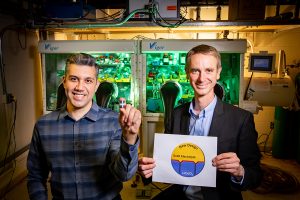
Solid-state batteries pack a lot of energy into a small space, but their electrodes are not good at keeping in touch with their electrolytes. Liquid electrolytes reach every nook and cranny of an electrode to spark energy, but liquids take up space without storing energy and fail over time. Researchers are now putting solid electrolytes in touch with electrodes made of strategically arranged materials – at the atomic level – and the results are helping drive better solid-state battery technologies.
A new study, led by University of Illinois Urbana-Champaign materials science and engineering professor Paul Braun, postdoctoral research associate Beniamin Zahiri, and Xerion Advanced Battery Corp. director of research and development John Cook, demonstrates how control over the atomic alignment of solid materials can improve the cathode-solid electrolyte interface and stability in solid-state batteries. The results are published in the journal Nature Materials.
Read the full story: https://news.illinois.edu/view/6367/1713475018
Read the full paper: Revealing the role of the cathode–electrolyte interface on solid-state batteries
Also featured:
MRS Bulletin, “Instilling order in electrode surfaces of solid-state batteries improves cell performance” by Boris Dyatkin, September 14, 2021.
Ceramic Tech Today, “Lining up for better performance: Researchers tailor interfaces in solid-state batteries” by Lisa McDonald, June 4, 2021.
New 3D microbatteries stand up to industry standard thin-film counterparts
The thin-film lithium-ion batteries used in microdevices such as portable and medical electronics may supply a good amount of power relative to their mass, but do not provide enough power for many devices due to their limited size. Researchers have introduced a fabrication process that builds microbatteries with thick, 3D electrodes using lithography and electrodeposition – and seals each unit in a gel electrolyte-filled package. The new prototype shows the highest peak power density of any reported microbatteries, the researchers said.
The new study, led by University of Illinois Urbana-Champaign postdoctoral researcher Pengcheng Sun and materials science and engineering professor Paul Braun, is published in the journal Advanced Materials.
Read the full story: https://news.illinois.edu/view/6367/1737488480
Read the full paper: “High-performance packaged 3D lithium-ion microbatteries fabricated using imprint lithography”
Researchers confront optics and data-transfer challenges with 3D-printed lens
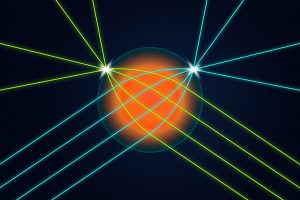 Researchers have developed new 3D-printed microlenses with adjustable refractive indices – a property that gives them highly specialized light-focusing abilities. This advancement is poised to improve imaging, computing and communications by significantly increasing the data-routing capability of computer chips and other optical systems, the researchers said.
Researchers have developed new 3D-printed microlenses with adjustable refractive indices – a property that gives them highly specialized light-focusing abilities. This advancement is poised to improve imaging, computing and communications by significantly increasing the data-routing capability of computer chips and other optical systems, the researchers said.
The study led by University of Illinois Urbana-Champaign researchers Paul Braun and Lynford Goddard and is the first to demonstrate the ability to adjust the direction in which light bends and travels through a lens with sub-micrometer precision.
Read the full story: Researchers confront optics and data-transfer challenges with 3D-printed lens
The results of the study are published in the journal Light: Science and Application: DOI: 10.1038/s41377-020-00431-3
Also featured:
Nanoscribe, “Direct laser writing of three-dimensional gradient-index optics” June 10, 2021.
MRS Bulletin, “3D printing technique forms microlenses with adjustable refractive indices” by Alejandro Burgos-Suazo, April 13, 2021.
Inside Science, “Scientists Increase data Speed with Tiny 3D-Printed Lens” by Tess Joosse, January 6, 2021.
Chemical & Engineering News, “A new way to make nanoscale lenses” by Ariana Remmel, December 17, 2020.
Photonics Media, “3D-Printed Lens Design Improves Data Transfer Possibilities” by Jake Saltzman, December 15, 2020.
Physics Today, “Silicon scaffolds support complex microlenses” by Christine Middleton, December 14, 2020.
Optics.org, “Researchers develop 3D-printed microlenses with adjustable refractive indices” December 7, 2020.
Congratulati ons to Prof. Paul Braun and Prof. Nancy Sottos!
ons to Prof. Paul Braun and Prof. Nancy Sottos!
Paul Braun and Nancy Sottos elected AAAS Fellows
AAAS Fellows are a distinguished cadre of scientists, engineers and innovators who have been recognized for their achievements across disciplines, from research, teaching, and technology, to administration in academia, industry and government, to excellence in communicating and interpreting science to the public.
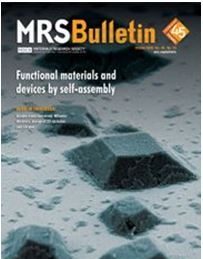
Braun as the Guest Editor for the October 2020 MRS Bulletin on Functional Materials and Devices by Self-Assembly.
Dmitri V. Talapin, Michael Engel, Paul V. Braun MRS Bulletin, Volume 45 / Issue 10, October 2020, pp 799 – 806 doi: 10.1557/mrs.2020.252 Published Online on 9 October 2020
Congratulations to Elizabeth Murphy, recipient of the 2020 National Science Foundation (NSF) Graduate Research Fellowship (GRF)! Murphy is a UIUC chemistry student and MRL research assistant with Paul Braun’s group.
“My research interest is developing structure-property relationships in functional polymeric materials,” -Murphy.
Ashish Kulkarni is the recipient of the 2020 Ross J. Martin Award for outstanding research achievement by a graduate student, and recognizes the quality and magnitude of Kulkarni’s research achievements.
Congratulations, Ashish, on this incredible achievement!
Materials Research Laboratory News
Braun led a team that developed a new templating system to help control the quality and unique properties of a special class of inorganic composite materials, including first author, Ashish Kulkarni.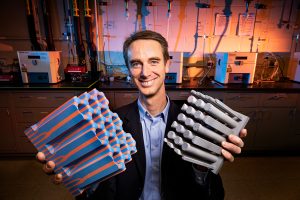
A.A. Kulkarni, E. Hanson, R. Zhang, K. Thornton, and P.V. Braun, Archimedean lattices emerge in template-directed eutectic solidification, Nature, 577, 355-358 (2020). DOI: 10.1038/s41586-019-1893-9
Nature, Illinois News Bureau, Advanced Science News, The American Ceramic Society, Materials Today, MRS Bulletin, Behind the Paper
APS Highlight: Ultraviolet Light Makes a Polymer Run Hot or Cold
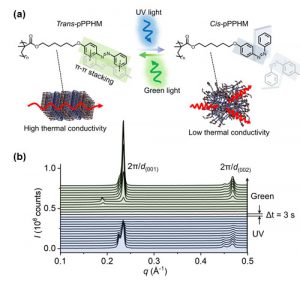
Controlling Thermal Conductivity of Polymers with Light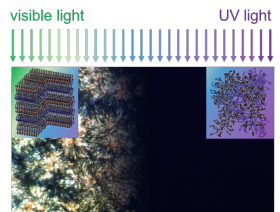
J. Shin, J. Sung, M. Kang, X. Sie, B. Lee, M.M. Lee, T.J. White, C. Leal, N.R. Sottos, P.V. Braun and D.G Cahill, Light-triggered thermal conductivity switching in azobenzene polymers, PNAS (2019). DOI: 10.1073/pnas.1817082116
Illinois News, EurekAlert!, APS Highlight
Braun research featured in Materials Research Society INTERSECTIONS Issue!
A Value-Added Materials Research Story—Self-healing Research Harnessed for Diverse Applications
K.A. Miller, E.G. Morado, S.R. Samanta, B.A. Walker, A.Z. Nelson, S. Sen, D.T. Tran, D.J. Whitaker, R.H. Ewoldt, P.V. Braun and S.C. Zimmerman, Acid-Triggered, Acid-Generating, and Self-Amplifying Degradable Polymers, Journal of the American Chemical Society (2019). DOI: 10.1021/jacs.8b07705
M. Ali, T.-H. Tsai and P.V. Braun, Amplified Detection of Chemical Warfare Agents using 2D Chemical Potential Gradients, ACS Omega, 3, 14665-14670 (2018). DOI: 10.1021/acsomega.8b01519
Illinois News Bureau, EurekAlert!
Congratulations to Jungwoo Shin, winner of the Racheff-Intel award (2018)! The award consists of a plaque and up to $1,000 financial support to attend a conference at which the student will present the relevant research.
Jungwoo also received the Dow Chemical Best Presentation Gold Award in Soft Materials (2018) for the combined research presentation with liquid crystal polymer and the azopolymer works.
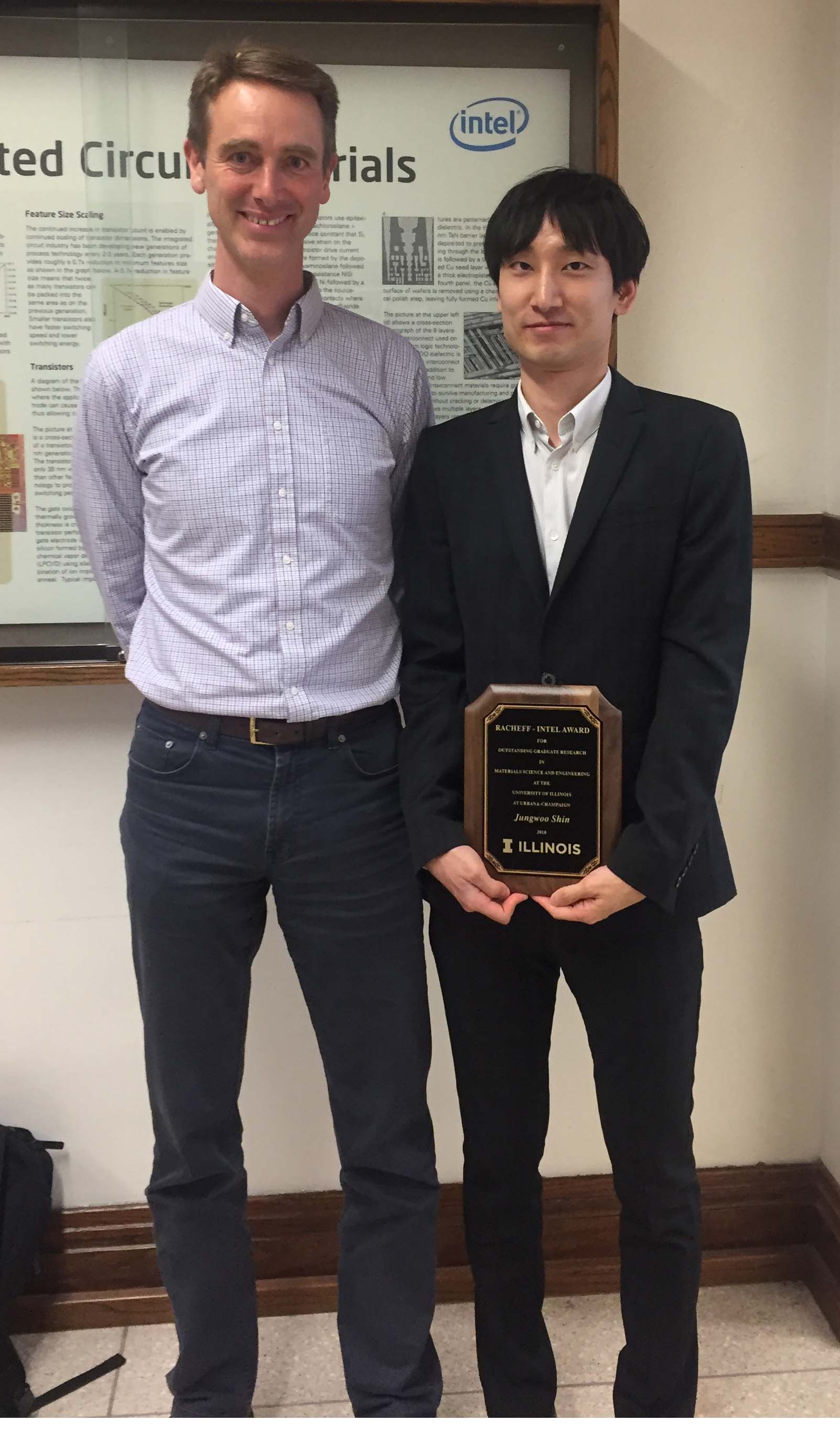
Story from Kali Serrano: Developing safety leaders at Illinois
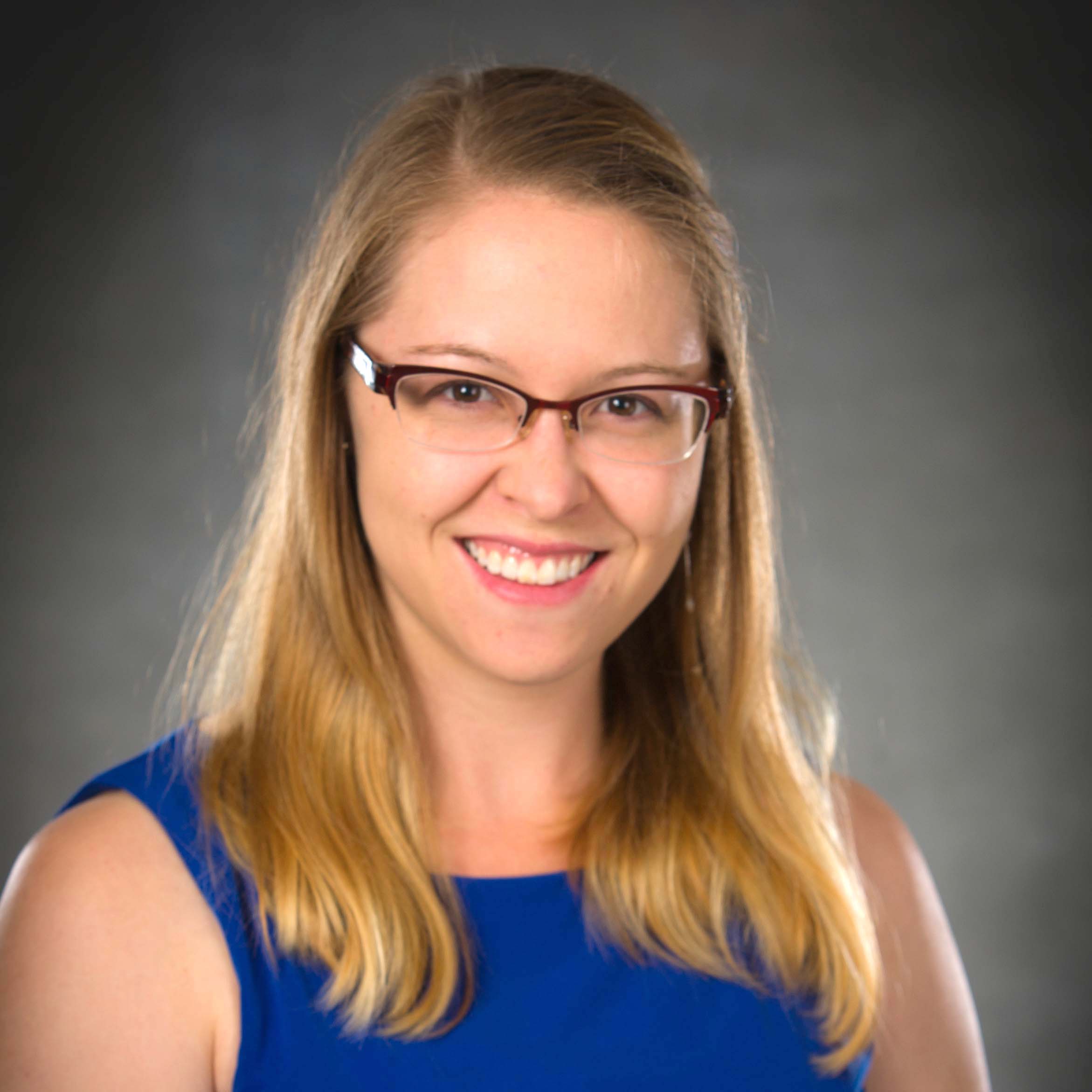
Braun group research from January 2008 is featured on the celebratory cover for the tenth anniversary of the launch of Nature Photonics.
January 2017 Cover
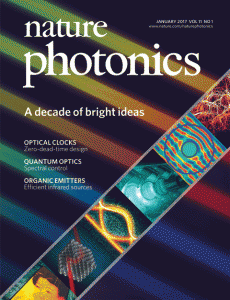
H. Zhang, H. Ning, J. Busbee, Z. Shen, C. Kiggins, Y. Huang, J. Eaves, J. Davis, T. Shi, Y.-T. Shao, J.-M. Zuo, X. Hong, Y. Chen, S. Wang, P. Wang, P. Sun, S. Xu, J. Liu, and P.V. Braun, Electroplating Lithium Transition Metal Oxides, Science Advances, 3, e1602427 (2017). DOI: 10.1126/sciadv.1602427
Illinois News Bureau, Ceramics.org, EurekAlert!, C&E News
N.A. Krueger, A.L. Holsteen, S.-K. Kang, C. Ocier, W. Zhou, G. Mensing, J.A. Rogers, M.L. Brongersma and P.V. Braun, Porous silicon gradient refractive index micro-optics, Nano Letters, 2016. DOI: 10.1021/acs.nanolett.6b02939
Illinois News Bureau, AAAS, U.S. DOE Office of Science, Photonics Media, SPIE Newsroom
M. T. Barako, A. Sood, C. Zhang, J. Wang, T. Kodama, M. Asheghi, X. Zheng, P.V. Braun, K. Goodson, Quasi-ballistic Electronic Thermal Conduction in Metal Inverse Opals, Nano Letters, 2016. DOI: 10.1021/acs.nanolett.6b00468
10 years in images
Nature Nanotechnology
Check it out!
Nat. Nanotech. 6, 277–281 (2011)
Bicontinuous electrodes
Nickel inverse opal forms one of the two phases of a battery cathode. Together with an electrochemically active phase, this electrode architecture allows for a rapid ion and electron exchange and transport for fast recharging batteries.
S.-K. Kang, R.KJ. Murphy, S.-W. Hwang, S.M. Lee, D.V. Harburg, N.A. Krueger, J. Shin, P. gamble, H. Cheng, S. Yu, Z. Liu, J.G. McCall, M. Stephens, H. Ying, J. Kim, G. Park, R.C. Webb, C.H. Lee, S. Chung, D.S. Wie, A.D. Gujar, B. Vemulapalli, A.H. Kim, K-M. Lee, J. Cheng, Y. Huang, P.V. Braun, W.Z. Ray and J.A. Rogers, Bioresorbable Silicon Sensors for the Brain with Implantable Wireless Operation, Nature, 530, 71-76 (2016). DOI:10.1038/nature16492
Many news agencies highlight our work on bioresorbable silicon electronic interfaces to the brain, published in Nature; CNN, IEEE Spectrum, Discover, New Scientist, United Press International, Chemical and Engineering News, German Public Radio, and many others, January, 2016.
Illinois News Bureau, CNN, Science Daily, C&EN
News-Gazette article featuring Paul Braun – Wired In
Congratulations to former Braun group member Jinyun Liu! His image was selected as a Finalist of the 2016 SCS Science Image Challenge at the University of Illinois!
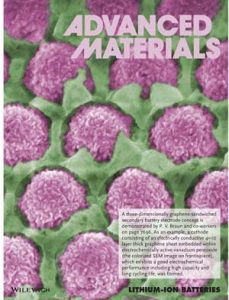
J. Liu, J. Wang, J. Kim, H. Ning, Z. Pan, S. Kelly, E. Epstein, X.-J. Huang, J. Liu and P.V. Braun, High Full-Electrode Basis Capacity Template-Free Three-Dimensional Nanocomposite Secondary Battery Anodes, Small, 11, 6265-6271 (2015). DOI: 10.1002/smll.201502538

H. Ning, J.H. Pikul, R. Zhang, X. Li, S. Xu, J. Wang, J.A. Rogers, W.P. King and P.V. Braun, Holographic Patterning of High-Performance on Chip 3-D Lithium Ion Batteries, PNAS (2015). DOI: 10.1073/pnas.1423889112
Illinois News Bureau, The Engineer, C&EN plus “News of the Week”, Kurzweilai.net, arstechnica , ECS Blog, Slash Gear, Engineering.com, 3DPrint.com, 3Ders.org, ExtremeTech, NewsKiller, Design Products & Applications, The Register
Congratulations to Braun group undergraduates Nathan Reed and Paige DeGarmo, poster award winners at the East Central Illinois Local ACS Section Undergraduate Research Conference! Nate won the “ECI Local Section Outstanding Poster Award” and Paige won the “Women Chemists Committee Outstanding Poster and Presentation Award.”
J. Kim, L.K. Aagesen, J.H. Choi, J. Choi, H.S. Kim, J. Liu, C.-R. Cho, J.G. Kang, A. Ramazani, K. Thornton and P.V. Braun, Template-Directed Directionally Solidified Three-Dimensionally Mesostructured AgCl-KCl Eutectic Photonic Crystals, Advanced Materials, 27, 4551-4559 (2015). DOI: 10.1002/adma.201502265

C. Zhang, A. Sitt, H.-J. Koo, K. Waynant, H. Hess, B. Pate and P.V. Braun, Autonomic Molecular Transport by Polymers Containing Programmed Chemical Potential Gradients, JACS, 137, 5066-5073 (2015). DOI: 10.1021/jacs.5b00240
C. Zhang, G.G. Cano, P.V. Braun, Linear and Fast Hydrogel Glucose Sensor Materials Enabled by Volume Resetting Agents, Advanced Materials, 26, 5678-5683 (2014). DOI: 10.1002/adma.201401710.
(e) Science News, Science Daily, Illinois News Bureau, Headlines & Global News, Gizmag, News-Medical.net, BioOptics World, TheHealthSite.com
J. Cho, M.D. Losego, H.G. Zhang, H. Kim, J. Zuo, I. Petrov, D.G. Cahill and P.V. Braun, Electrochemically Tunable Thermal Conductivity of Lithium Cobalt Oxide, Nature Communications, 5, 4035 (2014). DOI: 10.1038/ncomms5035
EurekAlert!, R&D Magazine, Azom.com, Ceramics.org
K.A. Arpin, M.D. Losego, A.N. Cloud, H. Ning, J. Mallek, N.P. Sergeant, L. Zhu, Z. Yu, B. Kalanyan, G.N. Parsons, G.S. Girolami, J.R. Abelson, S. Fan and P.V. Braun, Three-Dimensional Self-Assembled Photonic Crystals with High Temperature Stability for Thermal Emission Modification, Nature Communications, 4 (2013). DOI: 10.1038/ncomms3630
MotorTrend, Standford University, Science Codex, The American Ceramic Society, Materials 360
J.H. Pikul, H.G. Zhang, J. Cho, P.V. Braun and W. King: High Power Lithium Ion Micro Batteries from Interdigitated Three-Dimensional Bicontinuous Nanoporous Electrodes, Nature Communications, 4, 1732 (2013). DOI: 10.1038/ncomms2747
S. Odom, S. Chayanupatkul, B.J. Blaiszik, O. Zhao, A.C. Jackson, P.V. Braun, N.R. Sottos, S.R. White and J.S. Moore, A Self-Healing Conductive Ink, Advanced Materials, 24, 2578-2581 (2012). DOI: 10.1002/adma.201200196
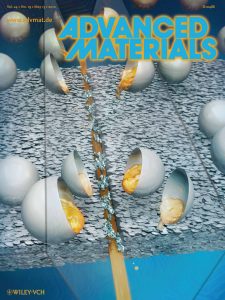
M. Losego, M.E. Grady, N.R. Sottos, D.G. Cahill and P.V. Braun: Effects of Chemical Bonding on Heat Transport Across Interfaces, Nature Materials, 11, 502-506 (2012). DOI: 10.1038/NMAT3303
Ceramic Tech Today, ScienceDaily, Illinois News Bureau, NPR Audio Clip
S. Cataldo, J. Zhao, F. Neubrech, B. Frank, C. Zhang, P.V. Braun and H. Giessen: Hole-Mask Colloidal Nanolithography for Large-Area Low-Cost Metamaterials and Antenna-Enhanced SEIRA Substrates, ACS Nano, 6, 979-985 (2012). DOI: 10.1021/nn2047982

J. Zhao, C. Zhang, P.V. Braun and H. Giessen, Large-area low-cost Plasmonic nanostructures in the near infrared region for Fano resonant sensing, Advanced Optical Materials, 24, OP247-OP252 (2012). DOI: 10.1002/adma.201202109
Congratulations to Katilin Tyler, recipient of a Mavis Future Faculty Fellowship!
Congratulations to Chunjie Zhang, winner of the Materials Research Society Graduate Student Gold Award for his paper “Hydrogel Sensor Materials for Continuous Glucose Monitoring,” which was presented at the MRS Fall Meeting in Boston, MA.
Press related to Chunjie Zhang’s award (see page 4): http://www.dvidshub.net/publication/issues/14800
Congratulations to James Pikul, winner of the Materials Research Society Graduate Student Gold Award for his paper “High Power Primary Lithium Ion Micro Batteries,” which was presented at the MRS Fall Meeting in Boston, MA.
July 2011, Cover of Nature Materials, Vol. 10
E.C. Nelson, N. Dias, K. Bassett, S. Dunham, V. Verma, M. Miyake, P. Wiltzius, J. Rogers, J. Coleman, X. Li and P.V. Braun: Epitaxial growth of three-dimensionally architectured optoelectronic devices, Nature Materials (2011).
Materials Today, Technology Review by MIT, Science Daily, Photonics.com, R&D Mag
Podcast with Materials Today – “Optoelectronic photonic devices”
A. Radke, T. Gissibl, T. Klotzbucher, P. V. Braun and H. Giessen: Three-Dimensional Bi-Chiral Plasmonic Crystals Fabricated by Direct Laser Writing and Electroless Silver Plating, Advanced Materials, 23, 3018-3021 (2011). DOI: 10.1002/adma.201100543.

H. Zhang, X. Yu and P.V. Braun: Three-dimensional bicontinuous ultrafast-charge and -discharge bulk battery electrodes, Nature Nanotechnology, 6, 277-281 (2011). DOI: 10.1038/nnano.2011.38 (supplementary information)
Science, WGN TV, Science Daily, Green Car Congress, CHEMPHYSCHEM, Spiegel Online, Hybrid.CZ, Illinois News Bureau, The Economist, News-Gazette
Paul Braun is interviewed by the BBC – click to listen!
Paul Braun is interviewed by German Radio
Podcast with Materials Today – click to listen!
The research on Mechanochemically Active Polymers
(Mechanophores) by Nancy Sottos, Paul Braun, Jeff
Moore and Scott White was featured in the Popular
Science list of “10 Tech Concepts You Need to Know for 2011”
![]()
April 2010, Paul Braun selected for Humboldt Foundation Award
K.A. Arpin, A. Mihi, H.T. Johnson, A.J. Baca, J.A. Rogers, J.A. Lewis and P.V. Braun: Multidimensional Architectures for Functional Optical Devices, Advanced Materials, 22, 1084-1101 (2010). DOI: 10.1002/adma.200904096
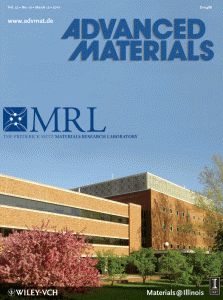
SEE THE FORCE: MECHANICAL STRESS LEADS TO SELF-SENSING IN SOLID POLYMERS
Parachute cords, climbing ropes, and smart coatings for bridges that change color when overstressed are several possible uses for force-sensitive polymers being developed by researchers at the University of Illinois.
U of I News Bureau
Mechanochemically Active Polymers Web Page
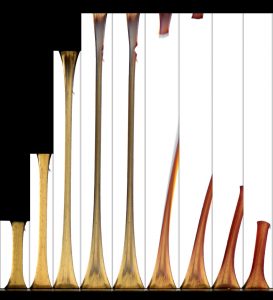
February 2009, Frontispiece of Advanced Materials, Vol. 21 No.6
Dramatic reduction in corrosion of a steel plate coated with a self-healing coating (right) as compared to a conventional coating is demonstrated. Two samples were scratched and placed in 5% NaCl for 5 days. The background is an optical image (2× magnification), in the foreground is an SEM image of the scratch. In the self-healing sample, the scratch has almost completely self-healed, while in the control sample, the scratch remains all the way down to the substrate.
Self-healing Polymer Coatings
New polymer coatings prevent corrosion, even when scratched (see press release)
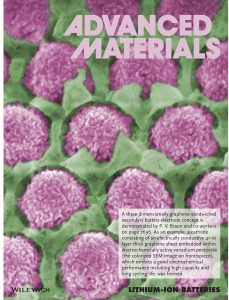
January 2009, Cover of Advanced Materials, Vol. 21 No.1
Here we report the use of direct laser writing topattern porous 3D structures from photo-responsive colloidal building blocks. Upon 2-photon exposure, the colloids become highly attractive, enabling localized control of aggregation behavior. 3D structures composed of porous walls are harvested by writing intoa colloidal sediment of these particles, followed by rinsing away unexposed colloidal species. Applications may include microfluidics, and studies of porous media, cellular growth and signaling, and colloidal physics. Cover art by Steven Eisenmann of the Beckman Institute VMIL.
Direct Laser Writing of Photoresponsive Colloids for
Microscale Patterning of 3D Porous Structures

January 2008, Cover of Nature Photonics, Vol.2 No.1
Photonic crystals, artificially engineered nanoscale structures that can manipulate the flow of light, show great promise for building sophisticated optical circuitry that can route, filter, store or suppress optical signals. However, fabricating such circuitry presents a great challenge as defects need to be carefully incorporated into the photonic-crystal structure with great precision. Although this has been accomplished for two-dimensional designs that confine light in a plane, it is still an ongoing challenge for so-called complete-bandgap materials, where the defects need to be embedded into a three-dimensional structure. In this issue, Paul Braun and colleagues report the introduction of defects into a silicon three-dimensional photonic crystal by using a technique called two-photon polymerization. The result is waveguides that guide near-infrared light around sharp corners.
Article p52,News & Views p9, UIUC Press Release

Jeong-Ho Park and Paul V. Braun: Coaxial Electrospinning of Self-Healing Coatings, Advanced Materials (2009).
Nature Research Highlights, Nanowerk
Beckman Institute for Advanced Science and Technology – featuring an article with Paul V. Braun: SYNERGY Fall 2009
Mary M. Caruso, Stuart R. Schelkopf, Aaron C. Jackson, Alexandra M. Landry, Paul V. Braun and Jeffrey S. Moore: Microcapsules Containing Suspensions of Carbon Nanotubes, Journal of Materials Chemistry, 19, 6093 (2009).
Technology Review by MIT, Materials World, CPU, Chemical Science
Jhy-Tsung Lee, Matthew C. George, Jeffrey S. Moore and Paul V. Braun: Multiphoton Writing of Three-Dimensional Fluidic Channels within a Porous Matrix, Journal of the American Chemical Society (2009).
Soo Hyoun Cho, Scott R. White and Paul V. Braun: Self-Healing Polymer Coatings, Advanced Materials, 21, 645-649 (2009).
tce today, Materials Today, One India, Red Orbit, The Post Chronicle, Thandian News, Times of the Internet, C&EN, UPI.com, Discovery Channel, MRS Bulletin, Eureka, Technology Today, Innovations Report, Illinois News Bureau
Stephanie A. Rinne, Florencio García-Santamaría and Paul V. Braun : Embedded cavities and waveguides in three-dimensional silicon photonic crystals, Nature Photonics, 2, 52-56 (2008).
optics.org, physicsworld.com, Illinois News Bureau, Nanotechweb.org, Telepolis, c’t, Laser Focus World, NewScientist, ABC News
Beckman Institute researchers, led by Paul Braun and Ben Grosser, receive $1.99 million National Science Foundation MRI award to acquire nano-CT instrument (see press release)
June 2007, Cover of Advanced Materials, Vol. 19, Issue 12
Germanium inverse woodpile 3D photonic crystals with a large (25%) photonic band gap in the infrared (background image) were fabricated through a multistep replication procedure. A polymer scaffold was first created by direct-write assembly, followed by the conformal growth of oxide and semiconductor layers, and removal of the polymer and oxide (foreground), …as reported on p. 1567 by F. García-Santamaría, M. Xu, V. Lousse, S. Fan, P. V. Braun,
and J. A. Lewis.

X. Yu, Y.-J. Lee, R. Furstenberg, J. O. White, and P. V. Braun: Filling Fraction Dependent Properties of Inverse Opal Metallic Photonic Crystals, Advanced Materials, 19, 1689-1692 (2007).
F. García-Santamaría, M. Xu, V. Lousse, S. Fan, P. V. Braun and J. A. Lewis: Germanium Inverse Woodpile Structure with a large photonic band gap, Advanced Materials, 19, 1567-1570, 2007.
Advances in Advance, Illinois News Bureau, Innovations Report, Semiconductor, nanotechwire.com, Physorg.com, PSS
May 2007: INVERSE WOODPILE STRUCTURE HAS EXTREMELY LARGE PHOTONIC BAND GAP
Researchers at the U. of I. have built an inverse woodpile structure of germanium, a material with a higher refractive index than silicon.
http://www.news.uiuc.edu/news/07/0521woodpile.html
November 2006, Cover of Advanced Functional Materials, Vol. 16, Issue 17
The direct ink writing of three-dimensional functional materials is detailed in the Feature Article by Lewis on p. 2193. The left side of the cover image displays schematic images that show the conversion of a direct-write polymer woodpile to a silicon hollow-woodpile structure. The 3 × 3 image matrix showcases the resulting silicon photonic crystal (center) surrounded by a higher-magnification view of a representative hollow silicon feature (ca. 1 m in diameter). The figure was prepared by F. Garcia-Santamaria, G. M. Gratson, and P. V. Braun.
The ability to pattern materials in three dimensions is critical for several technological applications, including composites, microfluidics, photonics, and tissue engineering. Direct-write assembly allows one to design and rapidly fabricate materials in complex 3D shapes without the need for expensive tooling, dies, or lithographic masks. Here, recent advances in direct ink writing are reviewed with an emphasis on the push towards finer feature sizes. Opportunities and challenges associated with direct ink writing are also highlighted.
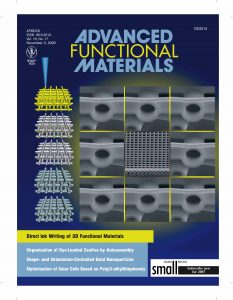
S. H. Cho, S. R. White, and P. V. Braun: Self-healing Polymer Coatings, abstract A3.54, Materials Research Society Fall Meeting, Boston, MA, December 2006.
Z. Ge, Y. Kang, T. A. Taton, P. V. Braun, and D. G. Cahill: Thermal transport in Au-core polymer-shell nanoparticles, Nano Letters, 5, 531-535 (2005).
Nanotechnology News Network, Nanotechnology Now, Nanotechweb.org, Nature Materials, Nature.com
June 2004, Cover of Langmuir, Vol. 20, Issue 13
Cover illustration by Wonmok Lee and Paul V. Braun showing to the left a scanning electron microscope image of a substrate patterned with a periodic array of dimples formed through focused ion beam lithography and to the right a laser scanning confocal microscope cross section of a 3-D colloidal crystal formed by gravity-driven sedimentation from a binary mixture of 1.18 m diameter colloidal microspheres and 6 nm diameter highly charged nanoparticles onto this patterned substrate. After microsphere settling, the nanoparticle solution surrounding the colloidal crystal was gelled in situ by introducing ammonia vapor, which increased the pH and enabled drying with minimal microsphere rearrangement. The confocal image shown here was generated by infilling the dried colloidal crystal with an index-matched fluorescent dye solution prior to imaging. These colloidal crystals have very low defect densities and may be suitable for use as photonic crystals and as templates for photonic band gap materials. The dimple pitch and the volume fraction of microspheres in solution were found to strongly impact the quality of the resulting colloidal crystal. For more information see “Nanoparticle-Mediated Epitaxial Assembly of Colloidal Crystals on Patterned Substrates” by Wonmok Lee, Angel Chan, Michael A. Bevan, Jennifer A. Lewis, and Paul V. Braun on pages 5262-5270 of this issue. Copyright 2004 American Chemical Society

H. Liang, T. E. Angelini, J.Ho, P. V. Braun and G. C. L. Wong: Molecular imprinting of biomineralized CdS nanostructures: Crystallographic control using self-assembled DNA-membrane templates, Journal of the American Chemical Society, 125, 11786-11787 (2003).
CNE, Chemical & Engineering News
W. Lee, S. A. Pruzinsky, and P. V. Braun: Multi-photon polymerization of waveguide structures within three-dimensional photonic crystals, Advanced Materials, 14, 271-274 (2002).
Chemical & Engineering News, Science, Nature, MRS Bulletin, Photonics, Technology Review, c’t, EE Times, Informationweek.com, Illinois News Bureau
“Tiny bubbles, sticky solutions,”The Toronto Star, February 16, 2004
View the complete Photonische Kristalle: Halbleiter für Licht story from c’t 26/2003
